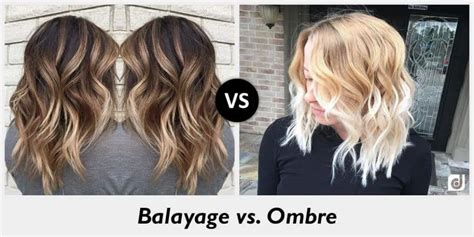When it comes to hair color trends, balayage and ombre reign supreme. Both techniques offer a sought-after dimensional effect, but they differ in approach, application, and results. Let’s dive into the key distinctions between these hair color methods to help you choose the one that best complements your desired look.

What is Balayage?
Balayage, derived from the French word “to sweep,” is a freehand hair painting technique that creates soft, blended highlights. A colorist uses a brush to paint color onto specific sections of hair, creating a sun-kissed, natural look. The technique focuses on creating seamless transitions between shades, resulting in a low-maintenance appearance.
What is Ombre?
Ombre is a two-toned hair color technique that involves gradually transitioning from one shade to another. Unlike balayage, ombre has a more defined contrast between colors. The darker shade typically anchors the roots, while a lighter shade gradually blends into the mid-lengths and ends. Ombre creates a bolder, statement-making look.
Key Differences
While balayage and ombre share similarities, they have distinct characteristics:
-
Freehand vs. Gradual: Balayage involves freehand painting, creating soft, blended transitions. Ombre, on the other hand, relies on a gradual blending of colors.
-
Maintenance: Balayage is generally lower maintenance than ombre, thanks to its seamless transitions. Roots may not be as noticeable with balayage, while they may need more frequent touch-ups with ombre.
-
Target Areas: Balayage can be applied throughout the hair, including layers and bangs, while ombre is primarily focused on the mid-lengths and ends.
-
Trend Level: Both balayage and ombre have been popular for years, but balayage has become increasingly dominant in recent seasons due to its versatile and natural-looking results.
Which Technique is Right for You?
The best choice between balayage and ombre depends on your personal preferences and hair goals:
- If you desire a subtle, sun-kissed look with low maintenance: Balayage is an excellent option.
- If you prefer a bolder, statement-making color transition: Ombre is a better fit.
- If you want to avoid frequent root touch-ups: Balayage again emerges as the superior choice.
Table 1: Balayage vs. Ombre at a Glance
| Feature | Balayage | Ombre |
|---|---|---|
| Technique | Freehand painting | Gradual blending |
| Color Transition | Soft, blended | Defined contrast |
| Maintenance | Low | Higher |
| Target Areas | Throughout hair | Mid-lengths and ends |
Pros and Cons
Balayage
- Pros: Natural-looking, low maintenance, versatile, can be applied to all hair types
- Cons: Can be time-consuming, may require multiple sessions for desired results
Ombre
- Pros: Bold, statement-making, creates a defined transition, can add volume
- Cons: Higher maintenance, frequent root touch-ups may be necessary, not suitable for all hair types
Market Trends
According to research conducted by Euromonitor International, the global hair color market is projected to reach $108.2 billion by 2026. Balayage and ombre are consistently among the most popular techniques, with balayage gaining a significant market share in recent years.
Celebrities and Influencers
Numerous celebrities and influencers have embraced both balayage and ombre. Jennifer Lopez, Beyonce, and Hailey Bieber are known for their stunning balayage locks, while Jessica Alba, Kristen Stewart, and Katy Perry have rocked ombre hairstyles.
Innovative Applications
The artistry of balayage and ombre has inspired creative new applications beyond traditional hair color. Some hairstylists are using these techniques on eyebrows and beards, creating subtle or bold color transitions for a cohesive and stylish look.
Conclusion
Whether you crave a natural-looking sun-kissed effect or a bolder color statement, balayage and ombre offer transformative hair color options. By understanding the key differences between these techniques, you can make an informed decision that will enhance your appearance and boost your confidence. Embrace the latest hair color trends and let your hair shine!
Additional Information
Table 2: Balayage vs. Ombre Application Process
| Step | Balayage | Ombre |
|---|---|---|
| 1 | Section hair | Section hair into top and bottom layers |
| 2 | Paint color onto selected sections | Apply color to the mid-lengths and ends |
| 3 | Blend color seamlessly | Blend color gradually at the transition point |
| 4 | Rinse and style | Rinse and style |
Table 3: Balayage vs. Ombre for Different Hair Types
| Hair Type | Balayage | Ombre |
|---|---|---|
| Straight | Versatile, creates natural-looking highlights | Can create a stark contrast, not ideal for very straight hair |
| Wavy | Enhances natural waves, adds dimension | Can create a dramatic effect, but may require more blending |
| Curly | Can be challenging to apply, but can add depth and warmth | Not recommended for very tight curls, as it can create an uneven transition |
| Fine | Balayage is ideal for adding volume and movement | Ombre may weigh hair down, not suitable for extremely fine hair |
| Thick | Balayage can create separation and dimension | Ombre is suitable for thick hair, but may require more color to achieve desired effect |
Table 4: Balayage vs. Ombre Price Range
| Technique | Price Range |
|---|---|
| Balayage | $100-$300 |
| Ombre | $150-$400 |
FAQs
Q: Is balayage cheaper than ombre?
A: Not necessarily. The cost of both techniques can vary depending on factors such as hair length, color complexity, and salon location.
Q: Is balayage better for long hair?
A: Both balayage and ombre can be suitable for long hair, but balayage may be more advantageous for creating a subtle, natural look.
Q: Can I do balayage or ombre at home?
A: While DIY hair color can be tempting, it is highly recommended to seek professional services to ensure proper application and avoid damage.
Q: How often should I get balayage or ombre touch-ups?
A: Touch-ups will vary depending on your desired color maintenance and hair growth rate. Generally, balayage may require touch-ups every 3-6 months, while ombre may need more frequent visits.
